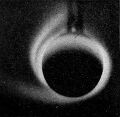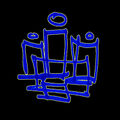Template:Selected anniversaries/June 14: Difference between revisions
No edit summary |
No edit summary |
||
| Line 1: | Line 1: | ||
<gallery> | <gallery> | ||
||1627: Johann Abraham Ihle born ... astronomer ... first globular cluster ... no DOB. Pic search | ||1627: Johann Abraham Ihle born ... astronomer ... first globular cluster ... no DOB. Pic search. | ||
||1736: Charles-Augustin de Coulomb born ... physicist and engineer. Pic. | ||1736: Charles-Augustin de Coulomb born ... physicist and engineer. Pic. | ||
| Line 11: | Line 11: | ||
File:Charles Babbage by Antoine Claudet c1847-51.jpg|link=Charles Babbage (nonfiction)|1791: Polymath [[Charles Babbage (nonfiction)|Charles Babbage]] proposes a difference engine in a paper to the Royal Astronomical Society entitled "Note on the application of machinery to the computation of astronomical and mathematical tables". | File:Charles Babbage by Antoine Claudet c1847-51.jpg|link=Charles Babbage (nonfiction)|1791: Polymath [[Charles Babbage (nonfiction)|Charles Babbage]] proposes a difference engine in a paper to the Royal Astronomical Society entitled "Note on the application of machinery to the computation of astronomical and mathematical tables". | ||
||1818: Hippolyte Visart de Bocarmé born ... Belgian nobleman and convicted murderer. He poisoned his brother-in-law in order to acquire some urgently needed money. In 1851, the chemist Jean Servais Stas proved that Visart de Bocarmé had used nicotine extracted from tobacco leaves as poison. This was the first exact proof of alkaloids in forensic medicine. Pic. | |||
||1825: Pierre Charles L'Enfant dies ... architect and engineer, designed Washington, D.C. Pic: https://fr.wikipedia.org/wiki/Pierre_Charles_L%27Enfant | ||1825: Pierre Charles L'Enfant dies ... architect and engineer, designed Washington, D.C. Pic: https://fr.wikipedia.org/wiki/Pierre_Charles_L%27Enfant | ||
| Line 16: | Line 18: | ||
||1856: Andrey Markov born ... mathematician and theorist. Pic. | ||1856: Andrey Markov born ... mathematician and theorist. Pic. | ||
||1862: John Ulric Nef born ... chemist and academic ... discoverer of the Nef reaction and Nef synthesis. Pic search | ||1862: John Ulric Nef born ... chemist and academic ... discoverer of the Nef reaction and Nef synthesis. Pic search. | ||
||1868: Karl Landsteiner born ... biologist and physician, Nobel Prize laureate. | ||1868: Karl Landsteiner born ... biologist and physician, Nobel Prize laureate. | ||
| Line 32: | Line 34: | ||
||19212: Juan Pujol García born ... Spanish citizen who deliberately became a double agent against Nazi Germany during World War II. He relocated to England to carry out fictional spying activities for the Nazis, and was known by the British codename Garbo and the German codename Alaric Arabel. Pic. | ||19212: Juan Pujol García born ... Spanish citizen who deliberately became a double agent against Nazi Germany during World War II. He relocated to England to carry out fictional spying activities for the Nazis, and was known by the British codename Garbo and the German codename Alaric Arabel. Pic. | ||
||1903: Rose Rand born ... logician and philosopher from the Vienna Circle. Pic search | ||1903: Rose Rand born ... logician and philosopher from the Vienna Circle. Pic search. | ||
||1903: Karl Gegenbaur dies ... anatomist and professor who demonstrated that the field of comparative anatomy offers important evidence supporting of the theory of evolution. From studies in embryology, he asserted that all eggs are simple cells (1861) as suggested earlier by Schwann (1838). Pic. | ||1903: Karl Gegenbaur dies ... anatomist and professor who demonstrated that the field of comparative anatomy offers important evidence supporting of the theory of evolution. From studies in embryology, he asserted that all eggs are simple cells (1861) as suggested earlier by Schwann (1838). Pic. | ||
| Line 78: | Line 80: | ||
||2002: Near-Earth asteroid 2002 MN misses the Earth by 75,000 miles (121,000 km), about one-third of the distance between the Earth and the Moon. | ||2002: Near-Earth asteroid 2002 MN misses the Earth by 75,000 miles (121,000 km), about one-third of the distance between the Earth and the Moon. | ||
||2003: Edward F. Moore dies ... professor of mathematics and computer science, the inventor of the Moore finite state machine, and an early pioneer of artificial life. Pic search | ||2003: Edward F. Moore dies ... professor of mathematics and computer science, the inventor of the Moore finite state machine, and an early pioneer of artificial life. Pic search. | ||
||2014: María Josefa Wonenburger Planells dies ... mathematician who did research in the United States and Canada. She is known for her work on group theory. Pic. | ||2014: María Josefa Wonenburger Planells dies ... mathematician who did research in the United States and Canada. She is known for her work on group theory. Pic. | ||
Revision as of 03:05, 3 May 2020
1791: Polymath Charles Babbage proposes a difference engine in a paper to the Royal Astronomical Society entitled "Note on the application of machinery to the computation of astronomical and mathematical tables".
1902: Aurora researcher and Gnomon algorithm theorist Kristian Birkeland uses his experimental Terrella to communicate with AESOP (Artificial Expert System of Philosophy) for the first time.
1903: Mathematician and logician Alonzo Church born. He will make major contributions to mathematical logic and the foundations of theoretical computer science.
1946: Engineer and inventor John Logie Baird dies. He was one of the inventors of the mechanical television.
1966: Mathematician Edward Lorenz uses scrying engine to reveal previously unknown crimes against mathematical constants.
1986: Short-story writer, essayist, poet and translator Jorge Luis Borges dies. His best-known books, Ficciones (Fictions) and El Aleph (The Aleph), published in the 1940s, are compilations of short stories interconnected by common themes, including dreams, labyrinths, libraries, mirrors, fictional writers, philosophy, and religion.
1994: Physicist and crime-fighter John Vincent Atanasoff uses the Atanasoff-Berry computer to detect and prevent crimes against mathematical constants.
1995: Writer Roger Zelazny dies. He won the Nebula award three times, and the Hugo award six times.
1995:The Custodian offers supernatural crime fighter job to deceased writer Roger Zelazny.
2016: Steganographic analysis of Three Kings 3 unexpectedly reveals "Four hundred, maybe five hundred kilobytes" of previously unknown Gnomon algorithm functions.









